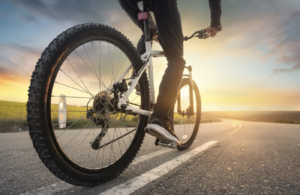Biking on the Road: Safety Tips and Legal Guidelines
 When you’re biking on the road, did you know that you’re considered a motorist? This means you must follow the same rules of the road as other motorists. Here are some essential tips and guidance to keep you safe and ensure you don’t confuse motorists.
When you’re biking on the road, did you know that you’re considered a motorist? This means you must follow the same rules of the road as other motorists. Here are some essential tips and guidance to keep you safe and ensure you don’t confuse motorists.
Obey Traffic Controls
As a cyclist, you must obey all traffic signs, signals, lights, and markings, just like a motorist. Here are key points to remember:
- Electric Power-Assisted Bicycles: These may be ridden on shared-use paths or sidewalks unless prohibited by local regulations.
- Traffic Signs and Lights: Cyclists must obey all traffic signs, lights, and markings.
- Red Lights: Under certain circumstances, cyclists can proceed through a solid red light after stopping completely for two full cycles of the light or two minutes, whichever is shorter. Cyclists must exercise due care, treat the red light as a stop sign, ensure it is safe to proceed, and yield the right of way to other vehicles.
References: §§ 46.2-800, 46.2-904, 46.2-924, 46.2-830, 46.2-833
Where to Ride
- Shared Use Paths and Sidewalks: Electric power-assisted bicycles (Class 1, 2, and 3) are allowed on all VDOT-owned shared-use paths unless prohibited.
- Flow of Traffic: Always ride with the flow of traffic on the right side of the highway.
- Positioning on the Road: Ride as close to the right curb or edge of the roadway as safely possible, except when overtaking another vehicle, preparing for a left turn, avoiding unsafe conditions, or riding on a one-way street.
- Highway Riding: Bicycles are not allowed on interstates and certain controlled-access highways unless there are barrier-separated facilities for bicycles.
- Sidewalks: Bicycles can be ridden on sidewalks unless local ordinances prohibit it. Always yield to pedestrians and give an audible signal before passing.
References: §§ 46.2-802, 46.2-808, 46.2-903, 46.2-905, 46.2-907, 46.2-904.1
Changing Lanes and Signaling
- Hand Signals: Use hand signals to indicate stops and turns. A right turn may be signaled with either the right arm or the left arm.
- Left Turns: Cyclists can make left turns as motorists do or as pedestrians by crossing the intersection straight, turning left at the corner, and proceeding.
References: §§ 46.2-846, 46.2-847, 46.2-848, 46.2-849
Passing
- For Cyclists: You may overtake and pass vehicles when safe. You can pass on the right or left and may ride off the road if necessary. Avoid passing on the right side of a vehicle that might turn right.
- For Motorists: Drivers must pass cyclists at a reasonable speed and leave at least three feet of space. If the lane is not wide enough, motorists must change lanes to pass safely. Motorists should not cross a solid line into a bicycle lane to pass.
References: §§ 46.2-839, 46.2-907, 46.2-841
By following these rules and guidelines, you can ensure a safer and more harmonious experience on the road for both cyclists and motorists. Stay vigilant, obey the laws, and ride safely!
For more information, visit the Virginia Department of Transportation’s Bike Safety web page.